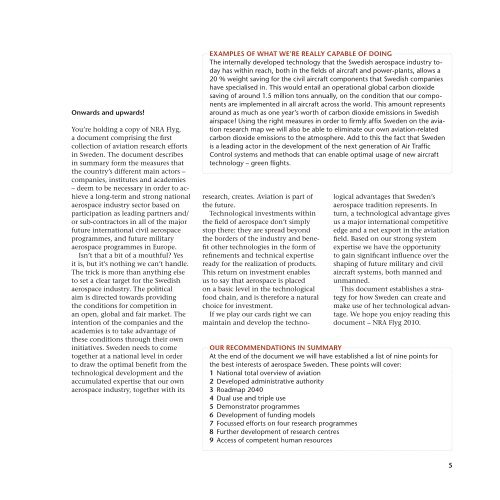NRA Flyg 2010 - Vinnova
NRA Flyg 2010 - Vinnova
NRA Flyg 2010 - Vinnova
You also want an ePaper? Increase the reach of your titles
YUMPU automatically turns print PDFs into web optimized ePapers that Google loves.
Onwards and upwards!<br />
You’re holding a copy of <strong>NRA</strong> <strong>Flyg</strong>,<br />
a document comprising the first<br />
collection of aviation research efforts<br />
in Sweden. The document describes<br />
in summary form the measures that<br />
the country’s different main actors –<br />
companies, institutes and academies<br />
– deem to be necessary in order to achieve<br />
a long-term and strong national<br />
aerospace industry sector based on<br />
participation as leading partners and/<br />
or sub-contractors in all of the major<br />
future international civil aerospace<br />
programmes, and future military<br />
aerospace programmes in Europe.<br />
Isn’t that a bit of a mouthful? Yes<br />
it is, but it’s nothing we can’t handle.<br />
The trick is more than anything else<br />
to set a clear target for the Swedish<br />
aerospace industry. The political<br />
aim is directed towards providing<br />
the conditions for competition in<br />
an open, global and fair market. The<br />
intention of the companies and the<br />
academies is to take advantage of<br />
these conditions through their own<br />
initiatives. Sweden needs to come<br />
together at a national level in order<br />
to draw the optimal benefit from the<br />
technological development and the<br />
accumulated expertise that our own<br />
aerospace industry, together with its<br />
Examples of what we’re really capable of doing<br />
The internally developed technology that the Swedish aerospace industry today<br />
has within reach, both in the fields of aircraft and power-plants, allows a<br />
20 % weight saving for the civil aircraft components that Swedish companies<br />
have specialised in. This would entail an operational global carbon dioxide<br />
saving of around 1.5 million tons annually, on the condition that our components<br />
are implemented in all aircraft across the world. This amount represents<br />
around as much as one year’s worth of carbon dioxide emissions in Swedish<br />
airspace! Using the right measures in order to firmly affix Sweden on the aviation<br />
research map we will also be able to eliminate our own aviation-related<br />
carbon dioxide emissions to the atmosphere. Add to this the fact that Sweden<br />
is a leading actor in the development of the next generation of Air Traffic<br />
Control systems and methods that can enable optimal usage of new aircraft<br />
technology – green flights.<br />
research, creates. Aviation is part of<br />
the future.<br />
Technological investments within<br />
the field of aerospace don’t simply<br />
stop there: they are spread beyond<br />
the borders of the industry and benefit<br />
other technologies in the form of<br />
refinements and technical expertise<br />
ready for the realization of products.<br />
This return on investment enables<br />
us to say that aerospace is placed<br />
on a basic level in the technological<br />
food chain, and is therefore a natural<br />
choice for investment.<br />
If we play our cards right we can<br />
maintain and develop the technological<br />
advantages that Sweden’s<br />
aerospace tradition represents. In<br />
turn, a technological advantage gives<br />
us a major international competitive<br />
edge and a net export in the aviation<br />
field. Based on our strong system<br />
expertise we have the opportunity<br />
to gain significant influence over the<br />
shaping of future military and civil<br />
aircraft systems, both manned and<br />
unmanned.<br />
This document establishes a strategy<br />
for how Sweden can create and<br />
make use of her technological advantage.<br />
We hope you enjoy reading this<br />
document – <strong>NRA</strong> <strong>Flyg</strong> <strong>2010</strong>.<br />
Our recommendations in summary<br />
At the end of the document we will have established a list of nine points for<br />
the best interests of aerospace Sweden. These points will cover:<br />
1 National total overview of aviation<br />
2 Developed administrative authority<br />
3 Roadmap 2040<br />
4 Dual use and triple use<br />
5 Demonstrator programmes<br />
6 Development of funding models<br />
7 Focussed efforts on four research programmes<br />
8 Further development of research centres<br />
9 Access of competent human resources<br />
5

















